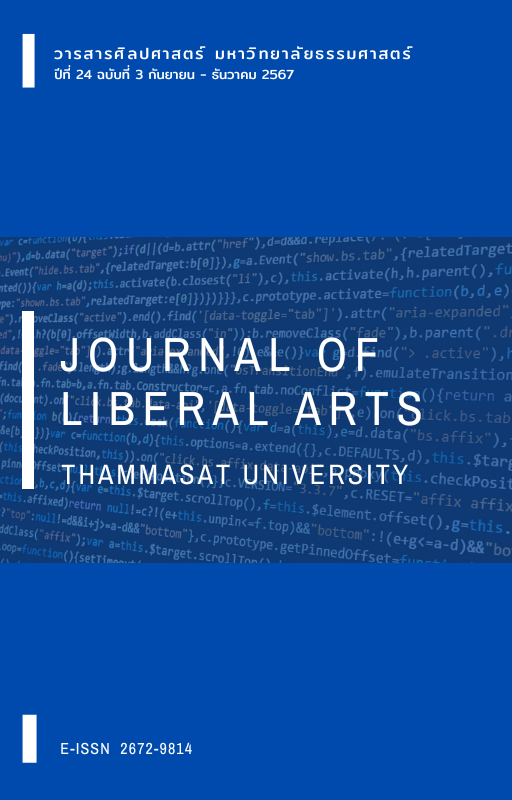การใส่รหัสและการถอดรหัสอุดมการณ์ของตัวบทเฟคนิวส์และตัวบทของผู้รับสารเฟคนิวส์ในสื่อสังคมออนไลน์
Main Article Content
บทคัดย่อ
การวิจัยเชิงคุณภาพชิ้นนี้มีวัตถุประสงค์เพื่อวิเคราะห์ตัวบทเฟคนิวส์ในสื่อสังคมออนไลน์จำนวน 40 ชิ้น โดยประยุกต์ใช้กรอบวิธีคิดการใส่รหัสและการถอดรหัสของสจ๊วต ฮอลล์ จากการศึกษาพบว่า เฟคนิวส์ในสื่อสังคมออนไลน์เป็นสารรูปแบบหนึ่งซึ่งใช้เพื่อการสื่อสารถึงอุดมการณ์ ผ่านการสร้าง การแชร์ และการบริโภคเฟคนิวส์ เฟคนิวส์ในสื่อสังคมออนไลน์ถูกใช้เป็นพาหนะ เป็นสนามในการใส่รหัสอุดมการณ์ ทำหน้าที่ปลุกอุดมการณ์ที่อยู่ในความคิดของผู้คน เข้าไปเสริมสร้างของเดิมให้พอกพูน หรือแม้แต่ทำหน้าที่ท้าทายสั่นคลอนอุดมการณ์เดิม ทั้งนี้การสร้างและดัดแปลงเฟคนิวส์อาศัยปฏิบัติการทางภาษาและสัญลักษณ์ ในขณะที่รูปแบบการถอดรหัสเฟคนิวส์ในสื่อสังคมออนไลน์มีความหลากหลาย คือ แบบตรงกันข้ามไม่เชื่อ แบบท้าทายแต่ไม่โต้แย้ง และแบบคล้อยตาม
Downloads
Article Details

อนุญาตภายใต้เงื่อนไข Creative Commons Attribution-NonCommercial-NoDerivatives 4.0 International License.
เอกสารอ้างอิง
Allport, G., & Postman, L. (1947). The psychology of rumor. Holt, Rinehart & Winston.
Anti-Fake News Center Thailand. (2021, December 31). The DSI is showing Thai figures, sharing fake news to 23 million people. https://www.antifakenewscenter.com/news/
Apornsri, S. (2019, November 19). Talk about rumors, big news, bigger news than you think, and good news with a journalist ‘Phansasiri Kularb’. The Momentum. https://themomentum.co/129416-autosave-v1/
Attkisson, S. (2018, August 28). Media bias: A new chart. https://sharylattkisson.com/2018/08/media-bias-a-new-chart
Hadlington, L., Harkin, L. J., Kuss, D., Newman, K., & Ryding, F. C. (2023). Perceptions of fake news, misinformation, and disinformation amid the COVID-19 pandemic: A qualitative exploration. Psychology of Popular Media, 12(1), 40-49.
Hall, S. (1973). Encoding and decoding in the television discourse. https://core.ac.uk/download/pdf/81670115.pdf
Hall, S. (1981). The whites of their eyes: Racist ideologies and the media. In G. Bridges & R. Brunt (Eds.), Silver Linings (pp. 28-52). Lawrence and Wishart.
Hall, S. (1985). Signification, Representation, Ideology: Althusser and the poststructuralist debates. Critical Studies in Mass Communication, 2(2), 91-114.
Li, J., Adnan, H. M., & Gong, J. (2023). Exploring cultural meaning construction in social media: An analysis of Liziqi’s YouTube channel. Journal of Intercultural Communication, 23(4), 01-12.
Jones, A. (2009). Losing the news: The future of the news that feeds democracy. Oxford University Press.
Kaimuk, W. (2008). Encoding and decoding of public service advertising in Thai television in 2008 [Unpublished master’s thesis]. Chulalongkorn University.
Kanozia, R., Arya, R., Singh, S., Ganghariya, G., & Narula, S. (2021). A study on fake news subject matter, presentation elements, tools of detection, and social media platforms in India. Asian Journal for Public Opinion Research, 9(1), 48-82.
Kedar, H. E. (2020). Fake news in media art: fake news as a media art practice vs. fake news in politics. Postdigital Science and Education, 2(1), 132-146.
Marchi, R. (2012). With Facebook, blogs, and fake news, teens reject journalistic “objectivity”. Journal of communication inquiry, 36(3), 246-262. https://doi.org/10.1177/01968599124587
Marcus, J. (1993). Mesoamerican writing systems: Propaganda, myth, and history in four ancient civilizations. Princeton University Press.
Marwick, B., Boettiger, C., & Mullen, L. (2018). Packaging data analytical work reproducibly using R (and friends). The American Statistician, 72(1), 80-88. https://doi.org/10.1080/00031305.2017.1375986
Mindich, D. T. (2005). Tuned out: Why Americans under 40 don't follow the news. Oxford University Press.
Palade, I., & Balaban, D. C. (2020). An analysis of COVID-19–related fake news from Romania. A pilot qualitative study. Journal of Media Research, 13(2), 27-43.
Panyawongsataporn, V. (2020). Rumour…Neither true nor false?: A review of rumour as the weapon of the weak. Journal of Journalism, 13(2), 48-73.
Patterson, T. E. (2007). Young people and news. A report from the Joan Shorenstein center on the press, politics and public policy. John F. Kennedy School of Government, Harvard University.
Quigley, C. N. (1999). Civic education: Recent history, current status, and the future. Albany Law Review, 62(4), 1425.
Scott, J. C. (1990). Domination and the arts of resistance: Hidden transcripts. Yale University Press.
Vereshchaka, A., Cosimini, S., & Dong, W. (2020). Analyzing and distinguishing fake and real news to mitigate the problem of disinformation. Computational and Mathematical Organization Theory, 26(3), 350-364.
Wickham, C. (1998). Gossip and resistance among the medieval peasantry. Past & Present, 160, 3-24.
Wahyono, S. B., Wirasti, M. K., & Ratmono, B. M. (2020). Audience reception of Hoax information on social media in the post-truth era. Jurnal Komunikasi Indonesia, 9(2), 7.
Yamthap, S., & Siriphon, A. (2021). Fake News and the Work of Journalists in digital era. Journal of Journalism, 14(2), 120-144.


